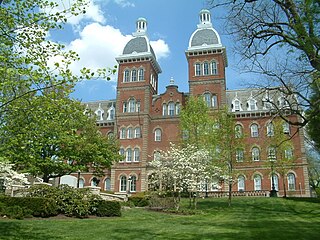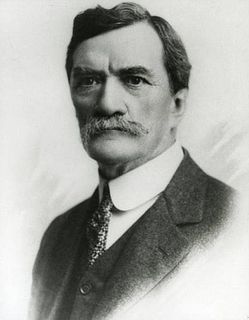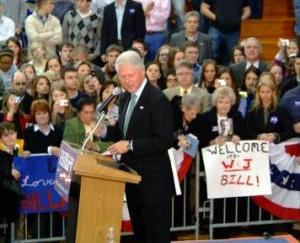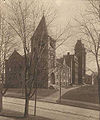
The Memorial Athletic and Convocation Center, often referred to as the MAC Center and the MACC, is a multi-purpose arena on the campus of Kent State University in Kent, Ohio, United States. The building is primarily used as an athletic venue that is home to five Kent State Golden Flashes varsity athletic teams, including the men's basketball and women's basketball teams. The arena also hosts women's volleyball, women's gymnastics, and wrestling as well as commencement exercises, speakers, and concerts throughout the year. The building houses the offices of the Kent State Athletic Department and the coaches of each of the university's varsity athletic teams.
University of Pittsburgh at Johnstown, also known as UPJ or Pitt-Johnstown, is a four-year, degree-granting state-related university institution that is a residential, regional campus of the University of Pittsburgh. The university is located in Richland Township, a suburban area of Johnstown, Pennsylvania, and was founded in 1927 as one of the first regional campuses of a major university in the United States. UPJ was listed among the best baccalaureate colleges in the North by U.S. News & World Report in its "America's Best Colleges 2010" annual college guide and ranked 92nd in the nation among baccalaureate colleges by Washington Monthly in 2019. UPJ is also listed among the "Best Colleges in the Northeastern Region" by The Princeton Review.

Lambert Fieldhouse is an athletic facility on the campus of Purdue University in West Lafayette, Indiana. It was built in 1937 on land bought by David Ross and George Ade as a replacement for Memorial Gymnasium to be the home of the Purdue basketball team, and also contained an indoor track. Memorial Gym was a 2,000 seat facility built in 1910 which had outgrown its usefulness, as the team had even resorted to playing games at the local high school gym, which seated twice as many as the gym did. In 1967, the team moved into the newly built Mackey Arena next door, and the building was remodeled to become a full-time track facility. The building also contains pool facilities, which were in use by the swimming and diving teams until 2001, when the Boilermaker Aquatic Center was completed.

The Gerald Ratner Athletics Center is a $51 million athletics facility within the University of Chicago campus in the Hyde Park community area on the South Side of Chicago, Illinois in the United States. The building was named after University of Chicago alumnus, Gerald Ratner. The architect of this suspension structure that is supported by masts, cables and counterweights was César Pelli, who is best known as the architect of the Petronas Towers.

Culver–Stockton College is a private Christian liberal arts college in Canton, Missouri. It was founded as Christian University in 1853 as the first institution west of the Mississippi River chartered specifically for men and women. As of fall 2014, the college enrolled 830 students.

The Florida Gymnasium is a historic building located on the campus of the University of Florida (UF) in Gainesville, Florida. It opened in 1949 as a 7,000-seat multi-purpose arena that was home to the Florida Gators men's basketball team and other UF indoor sports teams until it was replaced by the Stephen C. O'Connell Center in 1980. While serving as the home court of the basketball team, it acquired the nickname "Alligator Alley."

Memorial Gymnasium is a 2,500 seat multi-purpose arena in Charlottesville, Virginia. It opened in 1924. It replaced Fayerweather Gymnasium as home to the University of Virginia Cavaliers basketball team until University Hall opened in 1965.

Austin High School is a public high school in Austin, Minnesota. It is part of Austin Public Schools, established in 1857. The home of the Packers, the school has over 1,250 students; AHS prides itself on having strong academics, athletics, and fine arts. The school colors are Scarlet and White, and the sports team is the Packers. AHS is a member of the Big 9 Conference.

Joseph C. Trees Hall is a multipurpose student, staff, faculty recreational facility on the campus of the University of Pittsburgh in the Oakland section of Pittsburgh, Pennsylvania. First opened in 1962 with a second phase of construction was completed in 1965, Trees Hall houses the School of Education's Department of Health and Physical Activity, various student recreation facilities, a pool that serves as the home to Pitt's varsity men's and women's swimming and diving teams, and the primary training facility for Pitt's varsity women's gymnastics team.

The Washington & Jefferson Presidents are the intercollegiate athletic teams for Washington & Jefferson College. The name "Presidents" refers to the two presidential namesakes of the college: George Washington and Thomas Jefferson. W&J is a member of the Presidents' Athletic Conference, the Eastern College Athletic Conference, and play in Division III of the National Collegiate Athletic Association in both men's and women's varsity sports. During the 2005-2006 season, 34 percent of the student body played varsity-level athletics.

McMillan Hall is a building on the campus of Washington & Jefferson College in Washington, Pennsylvania, United States. Built in 1793, it is the only surviving building from Washington Academy. It is the eighth-oldest academic building in the United States that is still in use for its original academic purpose and is the oldest surviving college building west of the Allegheny Mountains.

Old Main is the main academic building at Washington & Jefferson College. It is the predominant building on campus and has served virtually every student since its construction. Its two identical towers, added in 1875, symbolize the union of Washington College and Jefferson College to form Washington & Jefferson College. The towers appear on the College seal, in a stylized version. The College fundraising operation founded "The Old Main Society" in 1996 to recognize individuals who utilize planned giving.

Hays Hall was a residence hall at Washington & Jefferson College. The architectural work was performed by Frederick J. Osterling and it was named after President George P. Hays. Construction was completed in 1903 and the new "fireproof" building was opened to Washington & Jefferson Academy students. Rooms were arranged in a suite style, with communal bathrooms on each floor, and shower baths on the 5th floor. In 1912, the Academy closed and Hays Hall was used by Washington & Jefferson College students. At various times, Hays Hall housed the bookstore and a dining hall. By 1968, Hays Hall had deteriorated to the point where it no longer able to house students, but the bookstore remained. In 1982, the building was declared a fire hazard and closed for all uses. While various efforts sought to renovate or restore Hays Hall, including a push to have it named a historical landmark, Hays Hall was demolished in 1994.
The Activities and Recreation Center, more commonly known as the ARC, is an athletic facility at the University of Illinois at Urbana–Champaign for current university students, members and guests. According to the university, Activities and Recreation Center is "one of the country's largest on-campus recreation centers".

Wills Gymnasium, often referred to as Wills Gym, was a multi-purpose athletic facility on the campus of Kent State University in Kent, Ohio, United States. Construction started in 1924 and the building was dedicated in 1925. It was the first dedicated gymnasium on the KSU campus, which had opened in 1913. Before the opening of Wills Gym, physical education classes and the intercollegiate and intramural sports teams used a variety of spaces for games and classes, both on campus in other buildings and off campus. The main gym seated approximately 4,000 people and the basement level included an indoor pool, locker rooms, and bowling alley. At the time, its capacity made it one of the largest facilities in the region. The building served as the primary home of the university's athletic teams and physical education department until 1950, when the Men's Physical Education Building opened. Wills Gym was the first permanent home of the Kent State Golden Flashes men's basketball team, and was also the original home venue for wrestling, men's swimming, men's and women's gymnastics, women's volleyball, and women's basketball.

Bartlett Gymnasium is a former athletic facility on the campus of the University of Chicago in Chicago, Illinois, United States, that has been converted into a campus dining hall.

Goddard Hall, originally known as Goddard Gymnasium, is a historic academic building on the campus of Tufts University in Medford, Massachusetts. Built in 1883 and designed by George Albert Clough, it was originally built to serve Tufts students as a gymnasium. In 1892, the building was remodeled and in 1930, the building was handed over to the Fletcher School of Law and Diplomacy for use as a library.


























